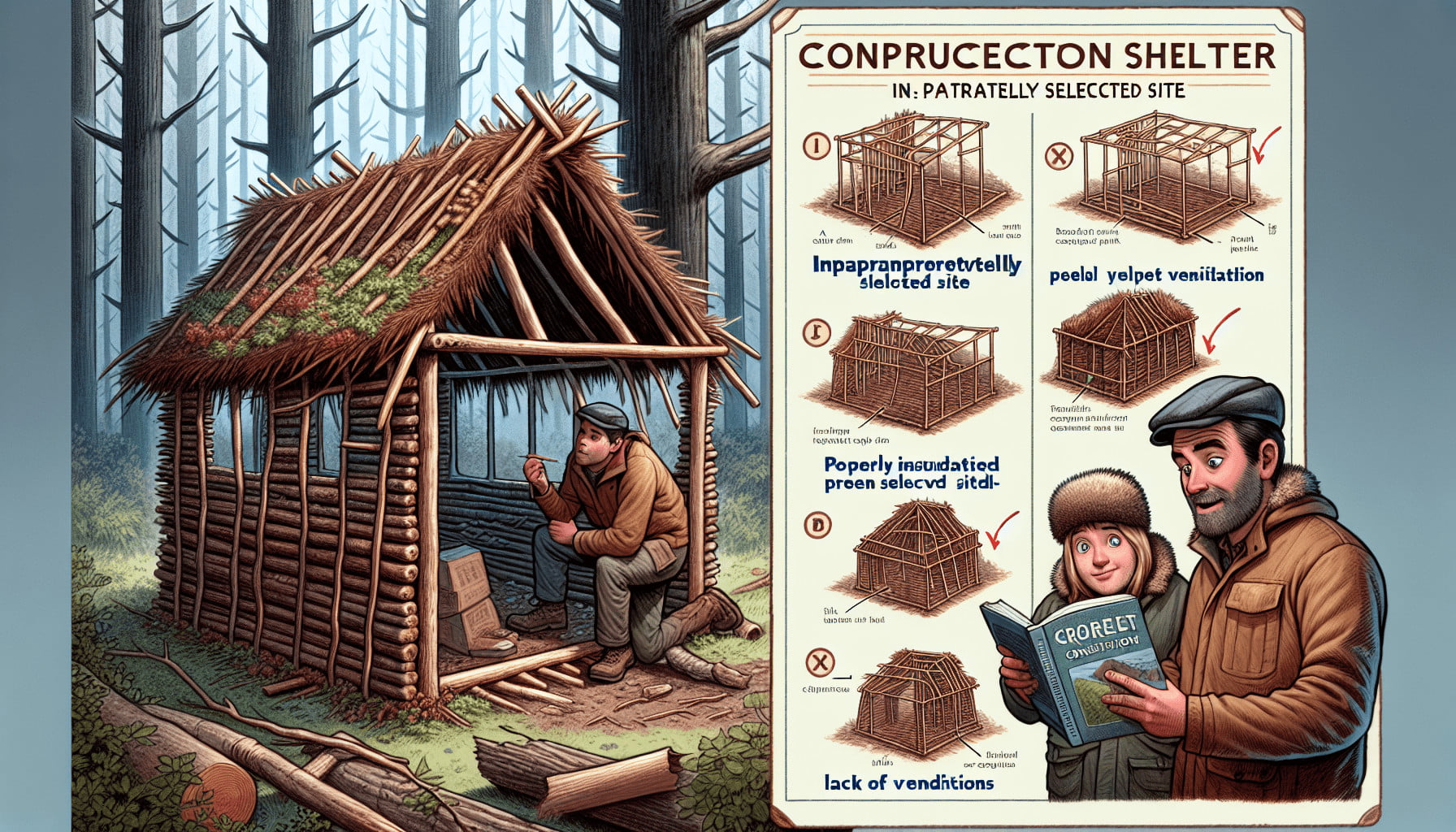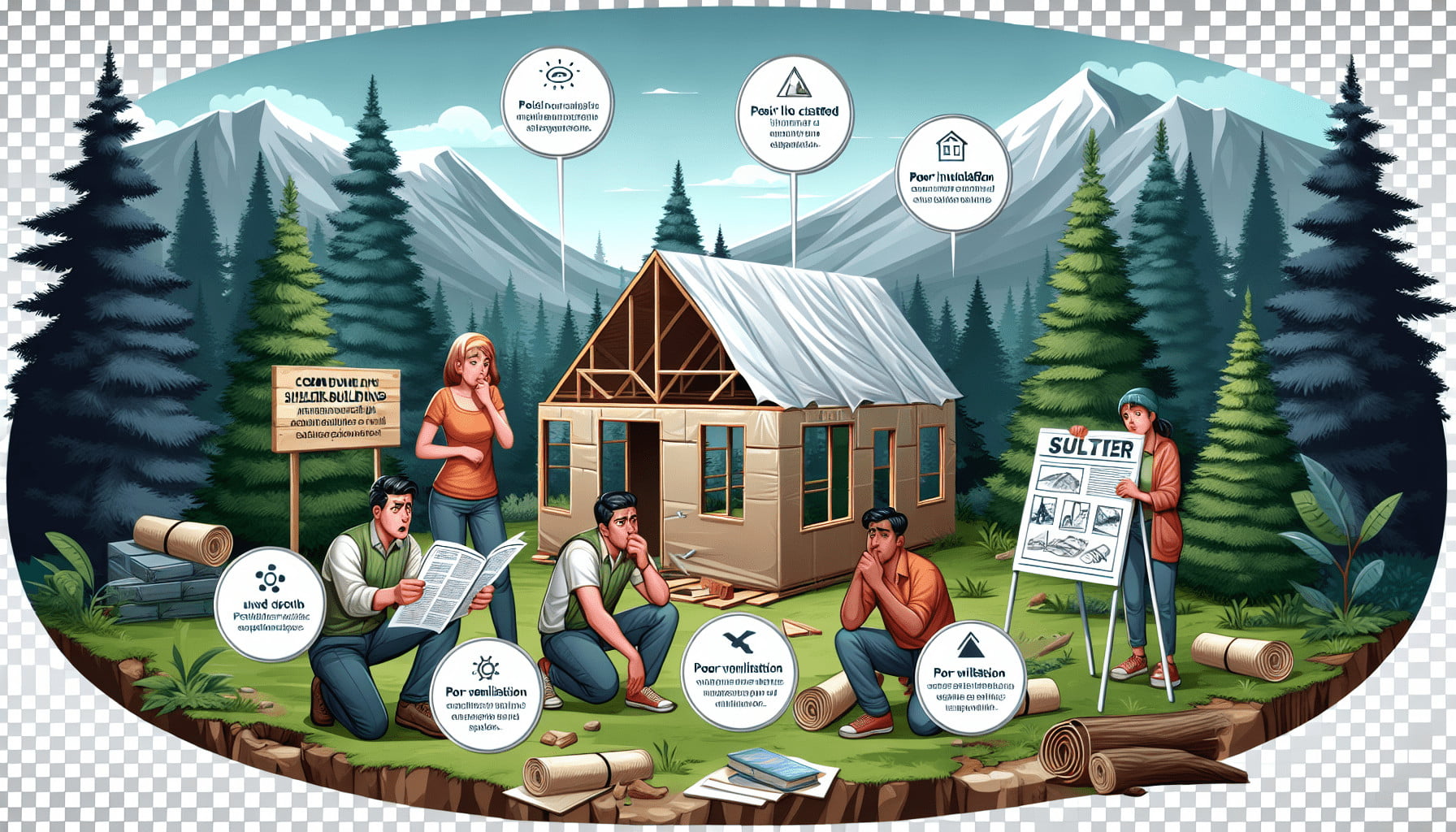Building a shelter can be a rewarding and practical skill to have, whether you’re a camping enthusiast or preparing for unexpected situations. However, there are common mistakes that can easily be made when constructing a shelter that may compromise your comfort and safety. This article highlights some of the most important mistakes to avoid, providing valuable tips and guidance to ensure your shelter is sturdy, functional, and able to withstand the elements. By following these suggestions, you’ll be able to create a shelter that not only protects you from the elements but also provides a cozy and secure retreat.

Choosing the Wrong Location
When it comes to building a shelter, one of the most critical decisions you will make is choosing the right location. Unfortunately, many people make the mistake of ignoring the terrain and weather conditions. It’s important to carefully assess the land before starting any construction. Is the ground level and stable? Are there any slopes or uneven surfaces that could pose a challenge during construction?
In addition to the terrain, it’s crucial to consider the weather conditions in your area. If you live in an area prone to heavy rainfall or strong winds, you need to take that into account when selecting a location for your shelter. Building in a flood-prone area or an area susceptible to landslides can have disastrous consequences.
Furthermore, failing to consider natural hazards is another common mistake when choosing a shelter location. Are there any nearby fault lines or areas prone to earthquakes? Is the location at risk of wildfires or hurricanes? These are all important factors to consider and should not be overlooked.
Lastly, building too close to water sources can be a grave mistake. While having easy access to water might seem convenient, it can also lead to potential flooding or water damage. It’s important to strike a balance between accessibility and safety when selecting a location for your shelter.
Inadequate Planning
Neglecting to create a detailed blueprint is a common mistake that can lead to a variety of problems during the construction process. A blueprint serves as a roadmap for your project, ensuring that all necessary steps and measurements are accounted for. Without a blueprint, you run the risk of making errors, wasting materials, and encountering setbacks along the way.
Lack of proper measurements and materials estimation is another pitfall to avoid. Before starting construction, it’s crucial to accurately measure the dimensions of your shelter and calculate the amount of materials needed. Underestimating or overestimating can lead to wasted resources and unnecessary expenses.
Failure to account for necessary permits and legal requirements is another mistake that can hinder the construction process. It’s important to research and understand the local building codes and regulations in your area. Failure to comply with these requirements can result in fines, delays, or even the need to demolish and rebuild your shelter.
Using Improper Construction Techniques
Proper construction techniques are essential for the structural integrity and longevity of your shelter. Not properly leveling the ground can cause stability issues, leading to uneven flooring and potential structural damage. It’s crucial to ensure that the foundation of your shelter is level and secure before proceeding with the construction process.
Furthermore, incorrectly anchoring the structure can result in instability and susceptibility to strong winds or earthquakes. It’s important to follow proper anchoring techniques recommended for the type of shelter you are building. This will help ensure that your shelter remains firmly in place during adverse weather conditions.
Using weak or unsuitable materials is another mistake to avoid. It’s crucial to select materials that are appropriate for the intended purpose of your shelter and can withstand the environmental conditions in your area. Cutting corners by using subpar materials can lead to structural weaknesses, compromising the safety and durability of your shelter.
Improper Ventilation
Proper ventilation is essential for a comfortable and healthy living environment within your shelter. Neglecting to incorporate ventilation openings can lead to poor air quality, excessive moisture buildup, and the potential for mold growth. It’s important to plan for adequate airflow by including windows, vents, or other ventilation systems in your shelter.
Insufficient airflow due to poor design is another mistake to avoid. It’s important to consider the layout and arrangement of your shelter to encourage natural airflow. This can be achieved by strategically placing windows and openings to promote cross ventilation. Proper ventilation not only improves air quality but also helps regulate temperature and prevents the buildup of unpleasant odors.
Ignoring the need for ventilation during construction is also a common mistake. Construction materials, such as paints, adhesives, and sealants, often release harmful fumes. Without proper ventilation, these fumes can accumulate, posing health risks to those involved in the construction process. It’s important to prioritize ventilation during construction to ensure a safe working environment.

Inadequate Insulation
Proper insulation is crucial for maintaining a comfortable and energy-efficient shelter. Neglecting to insulate the shelter properly can result in excessive heat loss or gain, leading to uncomfortable living conditions and increased energy consumption. It’s important to insulate not only the walls but also the roof and floor to prevent thermal bridging and ensure consistent temperatures throughout the shelter.
Using inadequate insulation materials is another mistake to avoid. It’s important to select insulation materials that have the appropriate R-value for your climate and meet building code requirements. Inadequate insulation materials can compromise the energy efficiency of your shelter and lead to higher heating or cooling costs.
Insufficient weatherproofing is another aspect of insulation that should not be overlooked. Proper weatherproofing involves sealing gaps and cracks to prevent air and moisture infiltration. Failing to adequately weatherproof your shelter can result in drafts, water damage, and reduced energy efficiency. It’s important to ensure that your shelter is properly sealed to protect against the elements.
Lack of Durability
A shelter should be built to withstand the test of time and environmental factors. Using substandard construction materials is a common mistake that can compromise the durability of your shelter. It’s important to select high-quality materials that are designed to withstand the specific demands of your environment. Cutting corners by using cheap or weak materials can result in frequent repairs or even structural failure.
Neglecting to reinforce weak areas is another mistake that can lead to structural issues. It’s important to identify and address any weak points in your shelter’s construction. Reinforcing these areas with additional supports or bracing will enhance the overall strength and durability of your shelter.
Failing to account for natural wear and tear is another pitfall to avoid. Over time, exposure to the elements and general use can take a toll on your shelter. It’s important to choose materials and construction methods that are designed to withstand these factors. Regular maintenance and inspections can also help identify and address any issues before they become bigger problems.
Insufficient Lighting
Proper lighting is essential for creating a comfortable and functional living space. Not considering the placement of windows and openings for natural light is a common mistake. Natural light not only improves the aesthetic of your shelter but also helps regulate mood, enhance productivity, and reduce the need for artificial lighting during the day. It’s important to strategically place windows and openings to maximize natural light.
Improper selection and installation of artificial lighting can also hinder the functionality of your shelter. Consider the purpose of each space within your shelter and select appropriate lighting fixtures accordingly. Adequate task lighting in areas such as kitchens and workspaces, as well as ambient lighting in living areas, will ensure a well-lit and inviting environment.
Failing to account for nighttime illumination needs is another mistake to avoid. It’s important to plan for adequate lighting during nighttime hours. Whether it’s outdoor lighting to enhance safety and security or interior lighting for nighttime activities, proper illumination is crucial for a well-rounded shelter.
Poor Drainage
Proper drainage is essential for preventing water damage and maintaining the structural integrity of your shelter. Neglecting to incorporate proper drainage systems is a common mistake that can lead to pooling water, water infiltration, and potential foundation issues. It’s important to plan for appropriate gutters, downspouts, and grading to ensure efficient water runoff.
Insufficient slope and runoff management can also result in drainage problems. If the surrounding land slopes towards your shelter, it can lead to water pooling or even flooding. It’s important to consider the slope of the land and implement proper grading measures to redirect water away from your shelter.
Failing to consider the impact of heavy rainfall or melting snow is another mistake that can have serious consequences. Water accumulation due to heavy rain or snowmelt can lead to flooding, water infiltration, and potential structural damage. It’s important to design your shelter and its surroundings to handle these weather events to prevent any water-related issues.
Neglecting Safety Measures
Safety should be a top priority when building a shelter. Not installing fire safety features is a serious oversight. It’s crucial to incorporate fire alarms, smoke detectors, and fire extinguishers into your shelter to ensure the safety of its occupants. Additionally, planning for multiple escape routes and ensuring that windows and doors are easily accessible during an emergency is essential.
Ignoring the need for emergency exits is another mistake that can have severe consequences. If a fire or other emergency occurs, having a clear and accessible exit route is critical. It’s important to plan for multiple escape routes that are easily identifiable and free from obstructions.
Failure to secure the shelter against intruders is another pitfall to avoid. It’s essential to prioritize the security of your shelter and implement measures such as sturdy locks, security cameras, and alarm systems. Protecting the well-being and belongings of those within your shelter should never be overlooked.
Lack of Comfort and Functionality
A shelter should provide comfort and meet the functional needs of its occupants. Failing to plan for necessary amenities, such as plumbing and electricity, is a common mistake. It’s important to consider the specific requirements of your occupants and design the shelter accordingly. Whether it’s installing plumbing for a bathroom or wiring for electricity, ensuring that the necessary amenities are in place is crucial.
Neglecting proper space utilization and organization is another mistake that can lead to a cramped and inefficient living space. It’s important to plan the layout of your shelter in a way that optimizes the available space and allows for easy movement and functionality. Properly organizing storage areas and carefully considering the placement of furniture and appliances will enhance the overall comfort and livability of your shelter.
Ignoring the need for accessibility and usability is another pitfall to avoid. It’s important to ensure that your shelter is accessible to individuals of all abilities. This may involve incorporating features such as wheelchair ramps, wider doorways, or accessibility-friendly bathroom fixtures. Additionally, considering usability by designing your shelter to be user-friendly in terms of intuitive layouts and easily operable features will greatly enhance the overall experience for its occupants.
By being aware of these common mistakes and taking the necessary precautions, you can ensure that your shelter is safe, comfortable, and functional. Remember to carefully choose the location, plan adequately, use proper construction techniques, prioritize ventilation and insulation, ensure durability, provide sufficient lighting and drainage, implement safety measures, and consider comfort and functionality. By doing so, you will be well on your way to building a successful shelter that meets your needs and stands the test of time.
